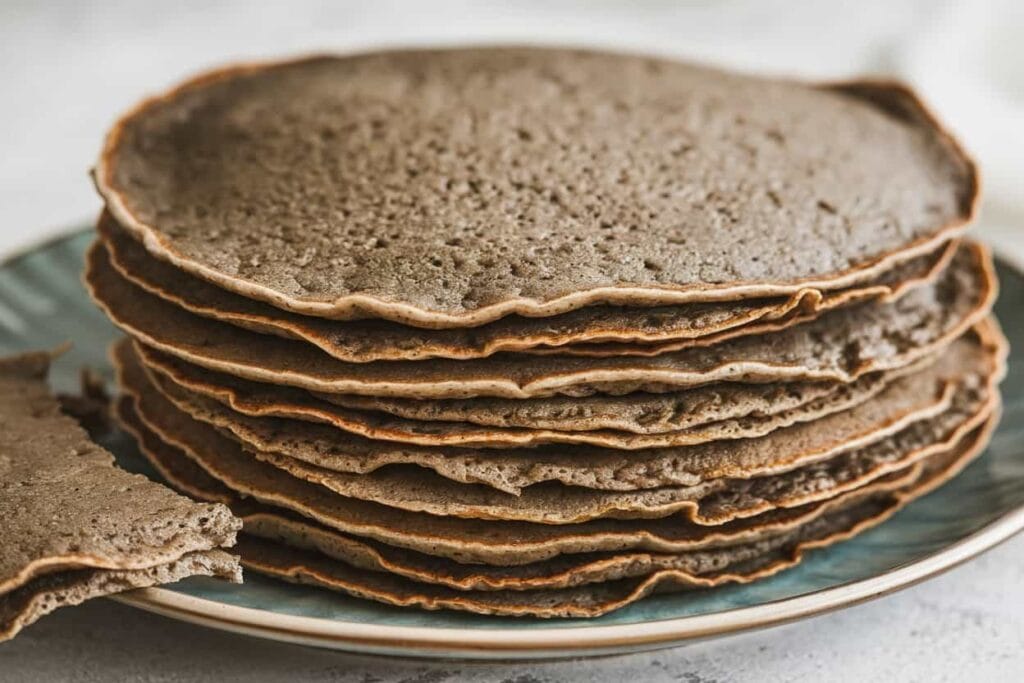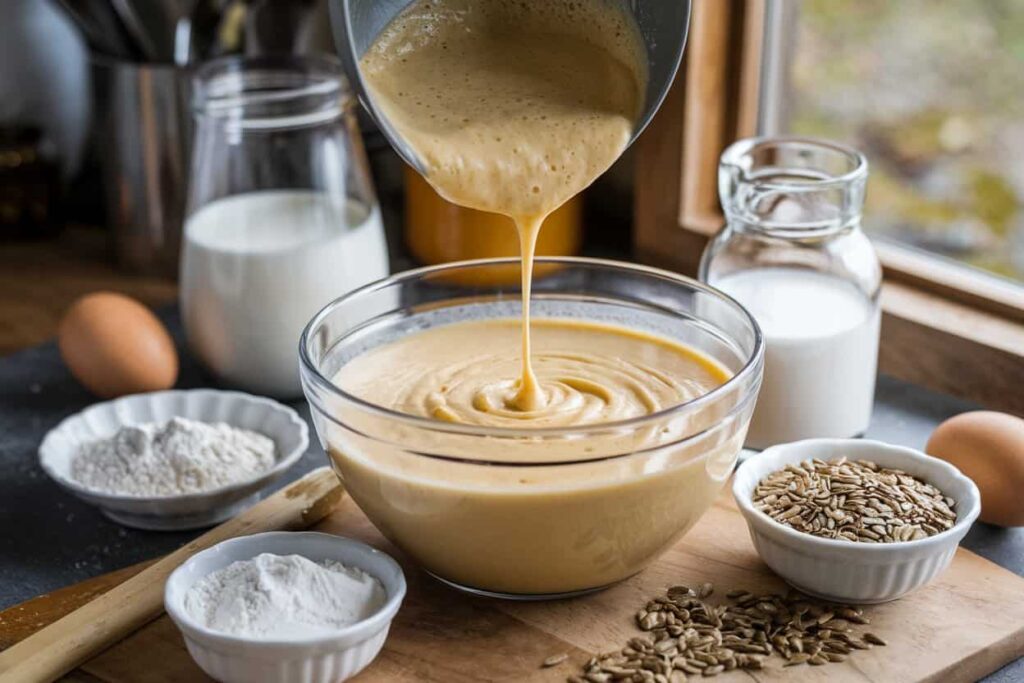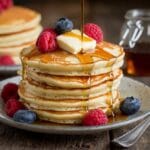Let’s be real: pancakes are one of life’s easiest pleasures. Whether you pile them up with syrup dripping down or keep them simple and fluffy, they’re a breakfast classic. But what if you’re out of eggs? Or maybe you’re skipping them for health or diet reasons. Does it make a difference? Can you still get that fluffy, tasty result? Stick around! We’re digging into what happens if you leave eggs out of pancakes and how to make it work.
Pancakes Without Eggs
Eggs are pretty standard in pancake recipes, right? Most of us use them without giving it much thought. But what if you left them out completely? Would your pancakes be a total flop? Not at all! Pancakes without eggs can still be tasty if you know a few simple tricks. You just need to learn some basics to make it work.
“Pancakes without eggs might seem risky, but with the right tricks, they can be just as fluffy and tasty!”
Role of Eggs in Pancakes
Why Eggs Are Used in Pancake Recipes
Eggs in pancake recipes, undoubtedly, act like the ultimate multitasker. Moreover, they bring structure, moisture, and a touch of richness, which ultimately makes every bite satisfying. However, without them, you’ll undeniably need to compensate for their absence. Nevertheless, don’t worry—it’s not rocket science!
Key Functions of Eggs in Pancake Batter
Eggs play several roles:
- Binding: Eggs hold everything together. Without them, the batter might feel loose and fall apart during cooking.
- Leavening: Ever wondered why pancakes rise? Eggs help with that airy lift.
- Moisture: No one likes dry pancakes. Eggs keep them soft and moist.
Texture and Flavor Contributions of Eggs
The texture of pancakes often depends on eggs. They add a fluffy, slightly chewy bite and a subtle richness. Without them, pancakes can feel a bit denser or even bland.
Common Problems When Pancakes Are Made Without Eggs

Alright, so what’s the worst that can happen if you skip eggs? Let’s break it down:
Flat and Dense Pancakes
Without eggs, pancakes can easily lose their fluffiness. For example, imagine a pancake as flat as a cookie—yep, that can happen. Eggs help pancakes rise by acting as a leavening agent. So, without them, you’ll need a substitute to get that same light, fluffy texture.
Crumbling or Falling Apart
Eggs are the glue that holds everything together. Without them, you might end up with pancakes that crumble or break apart when you flip them. It’s frustrating but avoidable with the right adjustments.
Lack of Rich Flavor
Eggs add richness to pancakes, giving them a buttery, satisfying taste. Skipping them can make your pancakes feel a little… meh. But don’t worry! You can easily boost flavor with substitutes like vanilla extract or mashed bananas.
Dry or Chewy Texture
Pancakes without eggs can sometimes turn out dry or overly chewy. Why? Eggs add moisture, and without them, you’ll need another ingredient to fill the gap.
Substitutes for Eggs in Pancake Recipes
The good news? You don’t need eggs to whip up amazing pancakes. There are plenty of substitutes to save the day!
Dairy-Based Substitutes (Milk, Yogurt, Buttermilk)
Milk, yogurt, or buttermilk can replace the moisture and binding effects of eggs. They also add a bit of tangy flavor. Just a few tablespoons of yogurt or a splash of buttermilk can make a big difference.
Plant-Based Alternatives (Flaxseeds, Chia Seeds, Applesauce)
Looking for a vegan-friendly option? Try these:
- Flaxseeds or Chia Seeds: Mix 1 tablespoon of ground flaxseeds or chia seeds with 2.5 tablespoons of water. Let it sit for 5 minutes, and voilà—an egg-like gel!
- Applesauce: Use 1/4 cup of unsweetened applesauce to replace one egg. It adds moisture and a hint of sweetness.
Commercial Egg Replacers
Need a foolproof solution? Grab a commercial egg replacer from the store. Brands like Bob’s Red Mill or Ener-G make blends specifically designed for baking and pancakes.
Tips for Choosing the Right Egg Substitute
Not all substitutes are created equal! Here’s how to pick:
- For Fluffiness: Opt for baking powder or buttermilk.
- For Binding: Use flaxseeds, chia seeds, or yogurt.
- For Flavor: Applesauce or mashed bananas add a nice twist.
| Substitute | Quantity per Egg |
|---|---|
| Flaxseeds/Chia Seeds | 1 tbsp + 2.5 tbsp water |
| Applesauce | 1/4 cup |
| Yogurt | 3 tbsp |
| Commercial Egg Replacer | Follow package instructions |
See? There’s a substitute for every need. The trick is choosing one that works for your pancake goals!
Benefits of Making Egg-Free Pancakes
Now that we’ve covered the substitutes, let’s talk about why you might want to skip the eggs altogether. Egg-free pancakes aren’t just a “last resort” option—they actually have some great perks!
Suitable for Vegans
If you’re on a vegan diet, eggs are obviously not an option. But that doesn’t mean you have to give up pancakes! Egg-free recipes open up plenty of options for fluffy, plant-based pancakes. They go great with vegan toppings like maple syrup, coconut whipped cream, or fresh fruits. So, you can still enjoy a delicious breakfast without breaking your diet.
Allergy-Friendly Option
Egg allergies are more common than you might think, especially in kids. With egg-free pancakes, you can make a tasty breakfast that everyone can enjoy without any stress. They’re great for family meals or gatherings where some people have dietary needs.
Budget-Friendly Solution
Let’s be honest—eggs can be pricey, especially if you’re buying free-range or organic ones. Leaving them out is a great way to save money without losing flavor. Substitutes like applesauce or flaxseeds are usually cheaper and stay fresh longer in your pantry.
“Who needs eggs when you can create pancakes that are budget-friendly, allergy-safe, and 100% delicious?”
Step-by-Step Guide to Making Egg-Free Pancakes

Ready to get flipping? Here’s a foolproof guide to making egg-free pancakes that will have you saying, “Eggs who?”
Ingredients Needed for Egg-Free Pancakes
Here’s what you’ll need for a simple batch of egg-free pancakes:
| Ingredient | Quantity |
|---|---|
| All-purpose flour | 1 cup |
| Baking powder | 2 teaspoons |
| Sugar | 2 tablespoons |
| Milk (or plant-based alternative) | 1 cup |
| Butter or oil | 2 tablespoons, melted |
| Egg substitute (e.g., flaxseed or applesauce) | 1 serving (as per table above) |
| Vanilla extract | 1 teaspoon |
| Pinch of salt | To taste |
Mixing and Preparing the Batter Without Eggs
Here’s the magic part! Follow these steps:
- Mix the dry ingredients: In a large bowl, whisk together the flour, baking powder, sugar, and salt.
- Combine the wet ingredients: In a separate bowl, mix the milk, melted butter, vanilla extract, and your chosen egg substitute.
- Blend them together: Gradually add the wet ingredients to the dry ingredients. Stir until just combined. Don’t overmix—lumps are totally fine!
- Let the batter rest: Give the batter 5–10 minutes to rest. This helps the leavening agents do their job, giving you fluffier pancakes.
Cooking Egg-Free Pancakes for Best Results
Now it’s time to cook:
- Preheat your skillet: Heat a non-stick skillet or griddle over medium heat. Lightly grease it with butter or cooking spray.
- Pour the batter: Scoop about 1/4 cup of batter onto the skillet for each pancake. Spread it slightly with the back of a spoon.
- Watch for bubbles: Cook until bubbles form on the surface and the edges look set (about 2–3 minutes).
- Flip carefully: Use a spatula to flip the pancake and cook the other side for another 1–2 minutes until golden brown.
- Repeat: Continue until all the batter is used up. Keep the cooked pancakes warm by placing them in a low-temperature oven.
Tips for Perfect Egg-Free Pancakes
Want next-level results? Follow these tips:
- Don’t skip the rest: Letting the batter sit helps the gluten relax and the pancakes fluff up.
- Adjust the heat: Too hot, and your pancakes will burn; too low, and they’ll turn out pale and tough.
- Use fresh ingredients: Check the expiration date on your baking powder—it’s crucial for fluffy pancakes!
With these steps, you’ll undoubtedly be flipping stacks of egg-free pancakes that are not only golden and fluffy but also completely irresistible. Furthermore, if you’re ready for even more, let me know! We can dive into some expert tips, common mistakes to avoid, and even a few delicious recipes to try!
Pro Tips for Perfect Egg-Free Pancakes
Egg-free pancakes can, undoubtedly, be as delightful as their egg-filled counterparts. However, they do require a few extra tricks to get just right. Therefore, here are some pro tips to ensure that every bite is not only golden but also irresistibly fluffy:
Maintaining Fluffiness Without Eggs
Fluffiness is a must, right? To keep your pancakes light and airy:
- Use enough leavening agents: Baking powder and baking soda are your best friends. Don’t skimp on them!
- Don’t overmix the batter: Stirring too much can activate the gluten in the flour, making your pancakes tough. Aim for a lumpy batter—it’s a good sign!
- Let the batter rest: A short rest allows the leavening agents to work their magic, creating air pockets for that perfect rise.
Enhancing Flavor and Texture
Egg-free doesn’t mean flavor-free. Here’s how to make your pancakes shine:
- Boost flavor with extracts: Add a splash of vanilla or almond extract for a fragrant twist.
- Incorporate spices: A pinch of cinnamon or nutmeg can elevate the flavor profile.
- Add mix-ins: Throw in chocolate chips, blueberries, or chopped nuts for texture and bursts of flavor.
Preventing Pancakes from Falling Apart
No one wants a pancake that crumbles when you flip it. Here’s how to keep them intact:
- Choose the right substitute: Binding substitutes like flaxseeds, chia seeds, or yogurt help hold the batter together.
- Don’t flip too early: Wait until you see bubbles and the edges look set before flipping.
- Cook on medium heat: Too high, and the pancakes may burn before they firm up enough to flip.
Common Mistakes to Avoid in Egg-Free Pancakes
Even the best cooks can stumble. Here are some common mistakes to dodge:
Using Too Much Liquid in the Batter
It’s tempting to add extra milk or water to thin the batter, but too much liquid can lead to pancakes that are soggy or fall apart. Aim for a thick but pourable consistency.
Skipping the Leavening Agents
Don’t ever underestimate the importance of baking powder and baking soda, as they are absolutely essential for giving your pancakes that lovely rise. Moreover, it’s crucial to double-check that they’re fresh to ensure the best possible results. Consequently, using expired leavening agents could lead to flat and disappointing pancakes.
Not Letting the Batter Rest
We get it—you’re hungry! But skipping the rest period can make your pancakes dense and flat. A 5–10 minute wait is worth it for fluffier results.
Comparing Egg-Based and Egg-Free Pancakes
So how do egg-free pancakes stack up against their traditional counterparts? Let’s compare:
| Aspect | Egg-Based Pancakes | Egg-Free Pancakes |
|---|---|---|
| Texture | Fluffy and slightly chewy | Can be fluffy with the right substitutes |
| Flavor | Rich and buttery | Depends on the substitute (e.g., fruity or nutty) |
| Allergy-Friendly | Not suitable for egg allergies | Safe for those with egg allergies |
| Vegan Option | No | Yes |
Recipes for Egg-Free Pancakes
Now it’s finally time to put everything you’ve learned into practice! So, here are some super easy recipes that you can try right away:
Classic Egg-Free Pancakes
These pancakes are not only light and fluffy but also absolutely perfect for any breakfast table. Furthermore, you can top them with your favorite syrup or fruit, and, as a result, you’re all set to enjoy a delicious meal!
- 1 cup all-purpose flour
- 2 teaspoons baking powder
- 2 tablespoons sugar
- 1 cup milk or plant-based milk
- 2 tablespoons melted butter
- 1 tablespoon ground flaxseed + 2.5 tablespoons water (egg substitute)
- 1 teaspoon vanilla extract
- Pinch of salt
Mix and cook as outlined in the step-by-step guide above. Enjoy warm!
Vegan Banana Pancakes
Do you want a fruity twist? If so, you can easily replace the egg with mashed banana for these naturally sweet and undeniably delicious pancakes:
- 1 cup all-purpose flour
- 1 teaspoon baking powder
- 1/2 teaspoon baking soda
- 1 tablespoon sugar
- 1 medium ripe banana, mashed
- 1 cup almond milk
- 1 tablespoon vegetable oil
- Pinch of cinnamon
Gluten-Free and Egg-Free Pancakes
Perfect for those with gluten or egg sensitivities:
- 1 cup gluten-free all-purpose flour
- 1 teaspoon baking powder
- 1/4 teaspoon xanthan gum
- 1 tablespoon sugar
- 1 cup oat milk
- 1 tablespoon ground chia seeds + 2.5 tablespoons water
- 1 teaspoon vanilla extract
- Pinch of salt
Follow the same mixing and cooking instructions, and you’ll have delicious pancakes ready in no time!
FAQs for “What Happens If You Don’t Put Eggs in Pancakes?”
Can you make pancakes without eggs?
Yes! Pancakes can be made without eggs by using substitutes like flaxseed, chia seeds, applesauce, yogurt, mashed bananas, or commercial egg replacers. These alternatives help maintain the texture and flavor of traditional pancakes.
What is the best egg substitute for pancakes?
The best egg substitute depends on your goal:
- For fluffiness: Baking powder or buttermilk
- For binding: Flaxseed or chia seeds (1 tablespoon mixed with 2.5 tablespoons of water)
- For flavor & moisture: Mashed bananas or applesauce (¼ cup per egg)
Do pancakes without eggs taste different?
Egg-free pancakes may have a slightly different texture or flavor depending on the substitute used. For example, applesauce and bananas add sweetness, while flaxseeds give a mild, nutty flavor.
Why do pancakes need eggs in traditional recipes?
Eggs provide structure, moisture, and help with leavening (making the pancakes rise). They also act as a binder, keeping the batter together, and contribute to a rich, slightly chewy texture.
Discover More Delicious Recipes
Looking to explore more exciting recipes? Check out these amazing ideas from Rita Flavors that complement your love for pancakes and beyond:
- What is the secret to making the best pancakes?
- Pancake Without Eggs and Milk
- Easy Pancake Recipe Without Eggs
Explore these recipes to bring new flavors and creative dishes to your table!
Conclusion: Embracing Versatility in Pancake Recipes
Egg-free pancakes might seem intimidating at first, but with the right techniques and substitutes, they’re a breeze to make. Whether you’re accommodating allergies, following a vegan lifestyle, or simply out of eggs, there’s no reason to miss out on this breakfast favorite. So grab your whisk, experiment with substitutes, and enjoy the endless possibilities of egg-free pancakes. Who knows? They might just become your new favorite!
Happy cooking with Rita chef ❤️!
Print
Pancakes Without Eggs
- Total Time: 20 minutes
- Yield: 6 to 8 pancakes 1x
- Diet: Vegetarian
Description
Fluffy light and delicious these pancakes without eggs are perfect for those with dietary restrictions or simply when you run out of eggs. Made with simple pantry staples and easy substitutes they are just as satisfying as traditional pancakes.
Ingredients
1 cup all-purpose flour
2 teaspoons baking powder
2 tablespoons sugar
1 cup milk or plant-based milk
2 tablespoons melted butter or vegetable oil
1 tablespoon ground flaxseed mixed with 2.5 tablespoons water (egg substitute)
1 teaspoon vanilla extract
Pinch of salt
Instructions
In a large bowl whisk together the flour baking powder sugar and salt until combined
In a separate bowl mix the milk melted butter vanilla extract and the flaxseed mixture
Pour the wet ingredients into the dry ingredients and stir gently until just combined leaving a few lumps
Let the batter rest for 5 to 10 minutes to allow it to thicken and improve texture
Preheat a non-stick skillet or griddle over medium heat and lightly grease with oil or butter
Pour 1/4 cup of batter onto the skillet for each pancake spreading slightly with the back of a spoon
Cook until bubbles form on the surface and the edges start to set about 2 to 3 minutes
Flip carefully and cook the other side for 1 to 2 minutes until golden brown
Serve warm with your favorite toppings such as maple syrup fresh fruits or nut butter
Notes
Do not overmix the batter to maintain fluffiness
Resting the batter helps create a lighter texture
For added flavor try adding cinnamon nutmeg or mashed bananas to the batter
If using plant-based milk adjust sweetness based on preference
- Prep Time: 10 minutes
- Cook Time: 10 minutes
- Category: Breakfast
- Method: Stovetop
- Cuisine: American
Nutrition
- Serving Size: 1 pancake
- Calories: 160 kcal
- Sugar: 4 g
- Sodium: 220 mg
- Fat: 5 g
- Saturated Fat: 2 g
- Unsaturated Fat: 3 g
- Trans Fat: 0 g
- Carbohydrates: 24 g
- Fiber: 1 g
- Protein: 3 g
- Cholesterol: 0 mg

